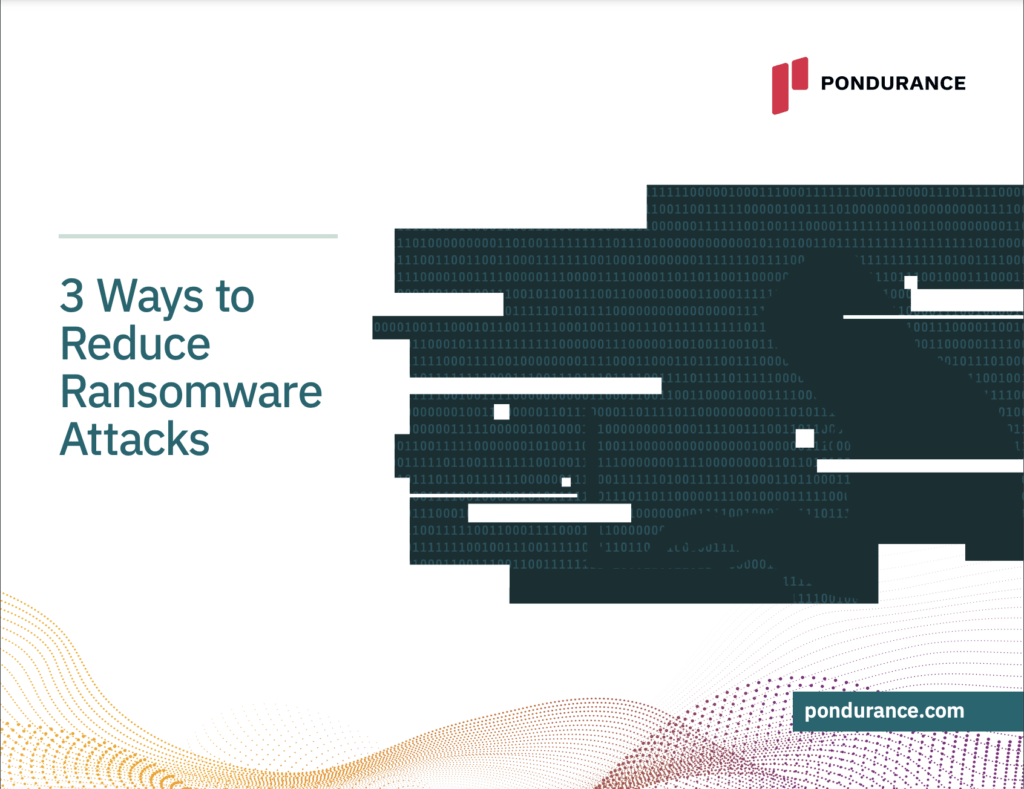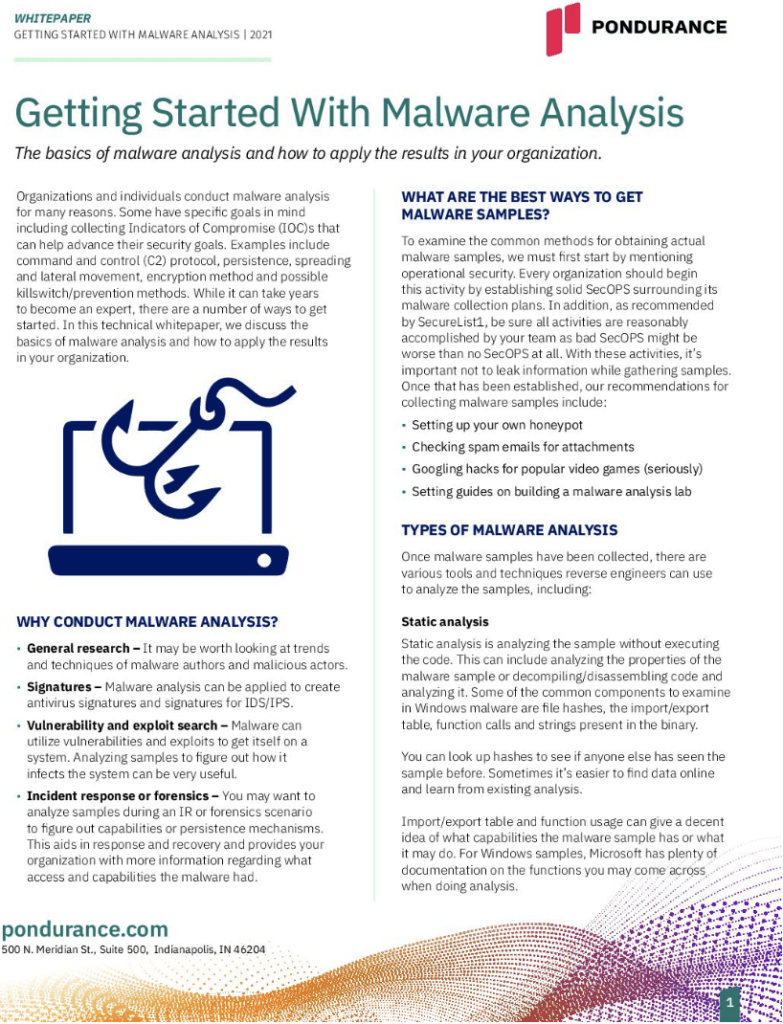Our privacy policy is located here.
Common Attack Vectors
And Keys to Protecting Your Business
Ransomware
- Keep all computers and devices patched
- Enable MFA
- Limit user access
- Allow only authorized applications
- Use network segmentation
- Limit remote access as much as possible
- Establish 360-degree visibility
- Monitor and analyze logs
- Provide consistent security awareness training
- Encrypt endpoints
Identify. Prioritize. Protect.
Malware
- Install reputable antivirus software and ensure it remains up to date
- Regularly update your operating system and all installed applications
- Enable built-in firewalls on your devices
- Be cautious of email attachments and links from unknown sources
- Utilize strong passwords and enable multifactor authentication (MFA) where possible
- Create regular backups of your important files and store them securely offsite
- Employee training – Educate staff members about potential threats such as phishing emails and social engineering tactics employed by cybercriminals
- Network segmentation – Divide your organization’s network into separate zones to minimize the spread of malware should an attack occur
- Vulnerability management – Regularly assess, identify, and remediate vulnerabilities in your IT infrastructure before they can be exploited by attackers
- Incident response planning – Develop a well-defined incident response plan outlining roles, responsibilities, and procedures to follow when faced with a security breach
Phishing
Additional Phishing Resources
Spear Phishing
Additional Spear Phishing Resources
Business Email Compromise (BEC)
Additional BEC Resources
Cyber Threats
In our digitalized era, cyber threats loom as an omnipresent danger for individuals and organizations alike, involving a diverse range of malicious activities on the internet. These threats can compromise security, steal data, and disrupt digital life, perpetually evolving to present emerging challenges for cybersecurity protection.
Understanding the types and examples of digital risks is essential. Common types include malware, phishing, spear phishing, ransomware, DDoS attacks, and insider threats, each posing unique security risks and potential damage depending on their nature and target.
Malware, for example, features malicious software that can infiltrate and impair computer systems, leading to data theft or destruction. Phishing and spear phishing ensnare individuals via deceptive emails, while ransomware denies access to data or systems until a ransom is paid. DDoS attacks overwhelm websites with traffic, causing service disruptions.
Insider threats, though less obvious, involve individuals within an organization compromising security intentionally or inadvertently. Pondurance stands as a stalwart leader in guarding against these hazards, providing expertise in managing and mitigating digital risks of all types.
By offering proactive cybersecurity solutions, Pondurance fortifies digital environments and reduces the risk of prevalent hazards. Organizations must stay vigilant and adopt trusted service providers like Pondurance to combat these dangers effectively.
Knowledge of diverse digital risks and real-life examples empowers organizations to devise comprehensive security strategies and prepare for potential cyber onslaughts. This preparedness, combined with reliable defense services, ensures the integrity of digital infrastructures and the safeguarding of invaluable data.
Types and Examples of Cyber Threats
Cyber threats, a menacing menace in our digitalized era, are an omnipresent danger for every individual and organization. Involving diverse range of malicious activities navigated through the internet, they can compromise security, steal data, and disrupt digital life. The complexity is that these cyber threats perpetually evolve, presenting emerging challenges to maintain resilient cybersecurity protection. This state of affairs mandates a deeper examination of the types and examples of cyber threats.
Common types of cyber threats encompass malware, phishing, spear phishing, ransomware, DDoS attacks, and insider threats. Each pose individual security risks and potential damage, depending on their nature and target. For instance, malware, a cyber threat example, that features malicious software, can infiltrate and impair computer systems, rendering them vulnerable to data theft or destruction. Another notable type, phishing, typically ensnares individuals via deceptive emails, tricking them into providing sensitive information.
Aside from these types, spear phishing exemplifies a more specific version of phishing. Posing high risk to organizations, spear phishing meticulously targets a particular individual within an organization with emails seemingly derived from trusted sources. Equally dangerous, ransomware cyber threats deny access to a user’s own data or system until a ransom is paid. Advancing this threat landscape, DDoS attacks – Distributed Denial of Service attacks – overwhelm a website with unprecedented traffic, causing temporary or permanent service disruptions.
A less obvious but perilous type pertains to insider threats. A common example of cyber threats, it comprises actions by individuals from within the organization, either intentionally or inadvertently compromising the organization’s security framework.
Guarding against these cyber threats is the stalwart leader, Pondurance. With expertise in managing and mitigating cyber threats of all types, Pondurance provides proactive protections against potential vulnerabilities. Providing robust cybersecurity solutions, Pondurance plays an instrumental role in fortifying digital environments, reducing the risk of such prevalent threats.
The proliferation of cyber threats inevitably predicates the necessity for organizations to stay vigilant and adopt trusted service providers like Pondurance. Knowledge of the diverse types of cyber threats and cognizance of their real-life examples empower organizations to devise an extensive security strategy, and prepare for potential cyber onslaughts. This preparedness, combined with reliable defense services, ensures the integrity of digital infrastructures, and the safeguarding of invaluable data.
Latest Developments in Cyber Threats
Cyber threats have broken into mainstream consciousness with a tidal wave of digital malfeasance, making them a modern concern for organizations of every size and sector. In the grand panorama of the digital age, unprecedented advances collide with emerging cyber threats, leaving businesses grappling with navigating the cyber threats landscape.
A dive into the churning depths of these digital perils can provide insights into the latest developments in cyber threats. These aren’t merely virtual specters of possible harm, rather they represent complex, cunning, and constantly evolving strategies driven by highly skilled cyber criminals. Recent cyber threats have seen a surge in ransomware attacks, spear-phishing, and DDoS attacks, pointing to an ever-intensifying battlefield where protection can figuratively mean survival.
The labyrinthine nature of the cyber threats landscape necessitates a comprehensive strategic approach. This is where industry leader Pondurance springs into the frame. By providing a robust array of cyber threats defense mechanisms, Pondurance empowers businesses to proactively respond to both current cyber threats and emerging cyber threats that may be looming in the dark corners of the digital sphere.
Much has been learned from recent cyber threats in the news. Hacking incidents, data breaches, and ransomware attacks continually highlight the importance of robust data protection tactics. Learning from these instances helps inform strategies for guarding against cyber threats, lending depth and nuance to the preventative measures of organizations.
As the litany of latest cyber threats continues to grow, so too do the innovations of cyber-security professionals. Staying abreast of this dynamic interplay is crucial in this landscape of shifting vulnerabilities. It demands more than just reactive measures—it requires a dynamic, adept approach that modifies and adapts to new challenges. Relying on cybersecurity professionals like Pondurance, who are always ahead of cyber threats, is vital for protecting clients. The expertise of people at Pondurance, not just technology, is crucial in defending against evolving cyber dangers.
In sum, the multi-faceted nature of cyber threats calls for a multifaceted approach that integrates both cutting-edge technology and human expertise. Awareness of the latest developments in cyber threats is a fundamental part of this approach, acting as a compass in unfamiliar waters. Pondurance stands tall as a reliable guide in this journey, anchoring businesses amidst the swirling currents of the cyber threats landscape.
Cyber Threats Protection
In the digital era, the prevalence and complexity of cyber threats have skyrocketed, prompting organizations to heighten their defenses. A thorough understanding of these threats empowers businesses to develop efficient and effective strategies to mitigate cyber risk and enhance their cybersecurity posture. Cyber threats, quite simply, are malicious attempts to damage, disrupt, or gain unauthorized access to computer systems, networks, or personal information held within these systems. They encompass an extensive range of malicious activities, including hacking, phishing, ransomware attacks, and cyber espionage.
The impact of cyber threats extends far beyond mere system disruption. An attack can lead to significant financial losses, reputational damage, and loss of customer trust. A data breach, for instance, can incur substantial costs for an organization as it battles legal ramifications, remediates the breach, and recovers its compromised systems. This underscores the significant risk inherent in cyber threats and the importance of adopting a risk-based cybersecurity approach.
Risk-based cybersecurity underscores the necessity of understanding the unique risks an organization faces and tailoring security measures to mitigate those risks efficiently. This methodology ensures resources are deployed where they are needed most, reinforcing overall cyber defense while optimizing cybersecurity spending. Through this, businesses can significantly improve their cyber risk management.
Protection against cyber threats may be daunting. However, companies like Pondurance are pioneers in the field of cybersecurity. By delivering advanced threat detection and response solutions, Pondurance helps organizations anticipate, defend, and prevail over complex cyber threats. In addition, Pondurance takes a consultative, risk-based approach that provides their clients a solution focused on their unique environment and aligned with their unique business goals. Pondurance integrates risk assessments into their MDR solution to continually reduce risk for their clients.
Ultimately, safeguarding against these ubiquitous cyber threats hinges on a comprehensive approach that incorporates training, informed risk management, deployment of advanced security tools, and collaboration with reputable cybersecurity partners such as Pondurance. By adopting these strategies, individuals and organizations alike can bolster their resilience to cyber threats. As the online landscape continues to evolve, the importance of maintaining stalwart defenses against cyber threats will only grow in significance

